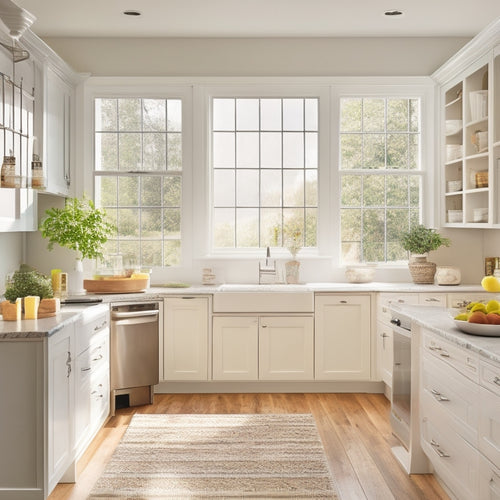
Taming the Chaos: Kitchen Cabinet Organization Solutions
Share
You're tired of kitchen cabinet chaos, and it's time to take control. Start by purging unnecessary items, categorizing kitchen essentials, and implementing space-saving solutions like floor-to-ceiling shelves and hanging baskets. Divide your kitchen into dedicated zones, and customize shelving to optimize workflow. Don't forget to utilize hidden storage areas, like behind doors and appliances, and contain clutter with dividers. As you get started, remember to set organizing goals and establish habits to maintain your newfound order. Now, take the next step to reveal your kitchen's full potential and discover the secrets to a stress-free cooking space.
Key Takeaways
• Implement a categorization system to group similar kitchen items together, making them easier to find and access.
• Use adjustable shelves, baskets, and dividers to maximize storage space and create a functional layout within cabinets.
• Label and sign each cabinet and shelf to create a visual system, ensuring everyone in the household knows where items belong.
• Designate specific zones within cabinets for frequently used items, and reserve higher or harder-to-reach shelves for less frequently used items.
• Regularly tidy up and maintain organization by establishing habits and routines, such as daily wiping down surfaces and weekly deep cleaning.
Kitchen Cabinet Chaos Challenges
Cluttered kitchen cabinets can quickly overwhelm you, making meal prep a challenging task and turning what should be a relaxing space into a source of stress.
To regain control, implementing effective decluttering strategies is vital. Start by purging items you no longer need or use, and categorize the remaining items into groups, such as baking supplies, cooking utensils, and dinnerware. This will help you identify what you need to store and where.
Next, consider space saving solutions, like adjustable shelving and baskets, to maximize your cabinet's vertical space. A functional layout is essential, so think about the 'golden triangle' concept, where your most frequently used items are easily accessible.
Customized shelving can also be a game-changer, allowing you to tailor your storage to your specific needs. By streamlining your kitchen cabinet organization, you'll be able to find what you need quickly, free up counter space, and enjoy a more peaceful cooking environment.
Assessing Storage Needs Effectively
To assess your storage needs effectively, you'll need to take a closer look at your kitchen cabinet's current state.
You'll want to identify the storage gaps that are causing clutter and disorganization, and then categorize your kitchen items into groups that make sense for your lifestyle.
Identify Storage Gaps
How efficiently do you utilize the space in your kitchen cabinets, and are there hidden areas where items are stacked haphazardly or left unused? To identify storage gaps, take inventory of your kitchen cabinets and assess what's working and what's not. Start by emptying your cabinets and sorting items into categories. This will give you a clear picture of what you have and where it should be stored.
| Area | Storage Solutions | Organizing Tips |
|---|---|---|
| Top Shelves | Install adjustable shelves or baskets | Store infrequently used items, like special occasion dishes |
| Middle Shelves | Use dividers or inserts | Organize items by category, like baking supplies or cooking utensils |
| Bottom Shelves | Invest in pull-out drawers or baskets | Store heavy or bulky items, like pots and pans |
Categorize Kitchen Items
You'll need to group your kitchen items into categories to assess your storage needs effectively, so start by separating essentials like cookware, dinnerware, and utensils from non-essentials like special occasion items or gadgets. This grouping strategy will help you identify what you use frequently and what can be stored away.
Next, create a labeling system to categorize items within each group, such as 'Baking Supplies' or 'Pantry Staples.' This will make it easier to find what you need and prevent clutter from building up again.
Once you've categorized your items, consider container solutions and shelf organization to maximize your storage space. Use baskets, bins, or dividers to store items like spices, oils, or snacks. Label each container so you can easily find what you need.
For shelf organization, consider a tiered system or adjustable shelves to accommodate items of different sizes. By categorizing your kitchen items and implementing a labeling system, container solutions, and shelf organization, you'll be well on your way to taming the chaos in your kitchen.
Set Organizing Goals
Establish Sorting Objectives
Your kitchen's distinct storage needs emerge when you analyze your categorized items, pinpointing the most urgent areas that need attention and optimization. Now, it's time to set specific, achievable goals for your kitchen cabinet organization project. This essential step guarantees you're targeting the right areas and allocating resources effectively.
To help you set realistic goals, consider the following factors:
| Area | Current Obstacles | Desired Outcomes |
|---|---|---|
| Countertops | Cluttered and tight | Clear and accessible |
| Cabinets | Disorganized and difficult to reach | Easy to access and well-stocked |
| Drawers | Jumbled and disorganized | Neatly arranged and efficient |
| Pantry | Overcrowded and expired items | Well-stocked and easy to navigate |
| Workflow | Inefficient and time-consuming | Smooth and streamlined |
Maximizing Vertical Storage Space
By installing floor-to-ceiling shelves, cabinets, or storage units, you can effectively capitalize on the often-wasted vertical space in your kitchen, thereby doubling or even tripling your storage capacity. This is especially useful for items that are infrequently used, such as special occasion dishes or cookbooks.
To make the most of this space, consider incorporating hanging baskets or adjustable shelves to store items like pots, pans, and kitchen utensils.
In addition to shelves and cabinets, you can also utilize the space on the back of doors with door organizers. These can be used to store spices, oils, or cleaning supplies, keeping them easily accessible while keeping your countertops clutter-free.
Another option is to use stacking bins to store dry goods like pasta, rice, or canned goods. These bins can be easily labeled and can be stored in a corner or against a wall, maximizing the use of your kitchen's vertical space.
Creating Zones for Efficiency
Dividing your kitchen into dedicated zones for cooking, storage, and food preparation can greatly enhance your workflow and reduce clutter. By creating a functional zone layout, you'll be able to move efficiently between tasks, saving time and energy.
Start by designating areas for specific activities, such as a cooking zone near the stove, a food prep zone near the countertops, and a storage zone near the pantry.
To maximize efficiency, incorporate organization hacks into each zone. For example, install a utensil organizer near the cooking zone, and a knife block near the food prep zone. In your storage zone, use functional design principles to optimize your cabinet layout, ensuring frequently used items are easily accessible.
Utilizing Hidden Storage Areas
As you plan your kitchen cabinet organization, don't forget to think outside the box - or in this case, inside the walls and above the appliances.
You're about to uncover some clever ways to utilize hidden storage areas that are often overlooked.
Behind the Scenes
You can maximize your kitchen's storage potential by exploring the hidden areas behind cabinet doors, appliances, and other fixtures, often overlooked but ripe for utilization. These spaces can be optimized with clever storage solutions, making the most of your kitchen's real estate.
| Hidden Storage Area | Organization Idea |
|---|---|
| Behind cabinet doors | Install a pegboard or a magnetic board to hang spices, oils, or frequently used utensils |
| Inside appliance garages | Use baskets or bins to store small appliances, cookbooks, or cleaning supplies |
| Under sink cabinets | Install a slide-out drawer or a turntable to access cleaning supplies or trash bags |
| Behind wall-mounted appliances | Utilize adhesive hooks or a narrow shelf to hang infrequently used items |
| Above kitchen cabinets | Implement a labeling system and color coding to categorize stored items, such as baking supplies or special occasion dishes |
Secret Drawer Space
By incorporating hidden compartments into your kitchen cabinet design, you can access additional storage space that remains concealed from view, freeing up valuable real estate for more frequently used items. This clever design element allows you to stash away infrequently used items, keeping them out of sight but still within reach.
Consider incorporating concealed compartments into your cabinets, such as a pull-out drawer behind a false back or a slide-out shelf behind a decorative panel. These unconventional solutions can be tailored to fit your specific needs, providing a secret stash for items like special occasion dishes, cookbooks, or even kitchen gadgets.
To maximize the potential of your hidden compartment space, think about the items you want to store and how you want to access them. Do you need a narrow drawer for spices or oils? Or perhaps a deeper compartment for infrequently used cookware? By carefully planning your undisclosed storage areas, you can create a more efficient and organized kitchen that still leaves room for your most frequently used items.
With a little creativity and clever design, you can unveil the full potential of your kitchen cabinets and create a more streamlined cooking space.
Above the Fridge
The often-overlooked space above your refrigerator can be converted into a valuable storage area, holding items like infrequently used cookbooks, special occasion tableware, or bulky kitchen appliances. By installing shelves, baskets, or cabinets, you can maximize this hidden space and keep your kitchen countertops clutter-free. Consider a decorative display of cookbooks or antique kitchenware to add a personal touch to your kitchen.
To ensure smooth access and cleaning, choose storage solutions with adjustable shelves and removable bins.
When storing items above the fridge, remember to clean the area regularly to prevent dust buildup. Cleaning tips: use a gentle cleaner and a soft-bristled brush to remove dust and debris from the shelves and containers.
Containing Clutter With Dividers
Five key zones within your kitchen cabinets can benefit from dividers to contain clutter and optimize storage space. By incorporating dividers, you can create separate areas for specific items, making it easier to find what you need when you need it.
For instance, drawer dividers can separate utensils, cooking supplies, and dinnerware, keeping them organized and preventing clutter from building up.
Shelf separators can also be used to categorize items like baking supplies, spices, and snacks. This will prevent them from getting jumbled together, making it difficult to find what you're looking for.
Additionally, consider implementing container organization systems, such as basket systems, to store items like cleaning supplies, oils, or condiments. These systems keep items contained and make them easily accessible.
Maintaining Organization Over Time
You'll need to establish habits and routines to secure your newly organized kitchen cabinets remain clutter-free and functional over time. This means incorporating time management into your daily routine to sustain the organization you've worked so hard to achieve.
Set aside a few minutes each day to tidy up your cabinets, putting away items that are out of place and wiping down surfaces.
Additionally, implement sustainable solutions to secure your organization system remains effective in the long run. For instance, designate a specific day each week to deep clean your cabinets and restock supplies. This will prevent clutter from building up and keep your kitchen running smoothly.
Related Posts
-

Corner Kitchen Storage Solutions to Boost Efficiency
To boost efficiency in your kitchen, you'll want to strategically utilize corner storage solutions. Start by measurin...
-

Deighton Associates Awarded for Excellence in Asset Management
You're likely curious about Deighton Associates' recent recognition for excellence in asset management. They've recei...

